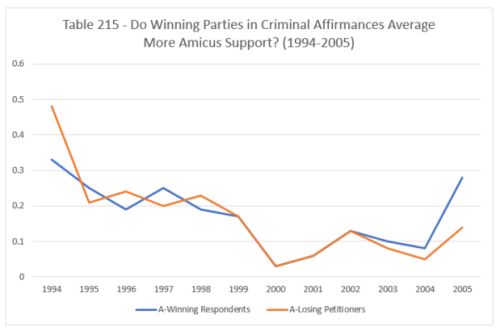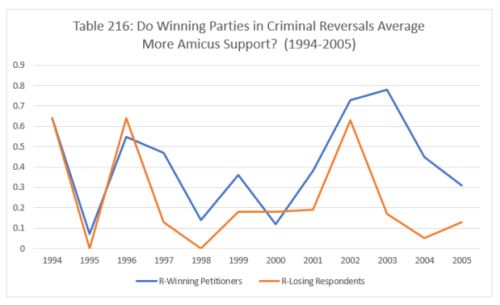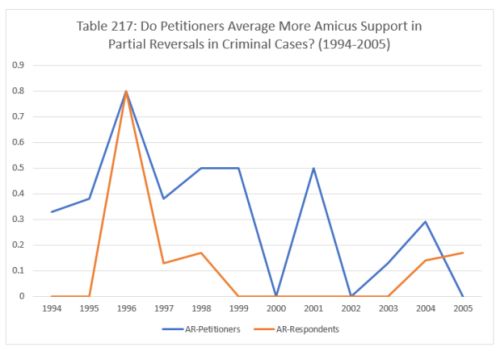Last week, we examined whether winning parties tended to average more amicus support in civil cases between 1994 and 2016. This week, we look at the Court's experience with amicus briefs in criminal cases.
In Table 215, we report the data for affirmances between 1994 and 2006. We see very little correlation between the number of amicus briefs and winners in such cases. In 1994, losers in affirmances averaged 0.48 amicus briefs to 0.33 for losing parties. In 1995, winners averaged 0.25 briefs in affirmances to 0.21 for losing parties. In 1996, losing parties averaged 0.24 briefs to 0.19 for winners. In 1997, once again the winning parties averaged slightly more briefs – 0.25 to 0.2. In 1998, losing parties averaged 0.23 amicus briefs to 0.19 for winners. From 1999 through 2002, the sides were even – 0.17 amicus briefs apiece in 1999, 0.03 in 2000, 0.06 in 2001 and 0.13 in 2002. In 2003, winning parties averaged 0.1 amicus briefs to 0.08 for losing parties. In 2004, winners averaged 0.08 briefs to 0.05 for losing parties. Finally, in 2005, winning parties averaged 0.28 amicus briefs in affirmances to 0.14 for losing parties.

We report the data for reversals in Table 216 below, and interestingly, our result is different – winners in criminal reversals did typically average more amicus support. In 1994, both sides averaged 0.64 briefs. In 1995, winners in reversals averaged 0.07 amicus briefs to 0 for losers. In 1996, losing parties in reversals averaged 0.64 briefs to 0.55 for winners.
In 1997, winners averaged 0.47 amicus briefs to 0.13 for losers. The following year, winners averaged 0.14 briefs to 0 for losers. In 1999, winners averaged 0.36 amicus briefs to 0.18 for losers. In 2000, winners averaged 0.12 briefs to 0.18 for losers. From 2001 through 2005, winning parties in reversals averaged more amicus briefs than losers each year – 0.38 to 0.19 in 2001, 0.73 to 0.63 in 2002, 0.78 to 0.17 in 2003, 0..45 to 0.05 in 2004 and 0.31 to 0.13 in 2005.

Finally, we review the cases with mixed results – partial affirmances and partial reversals. Petitioners averaged more amicus briefs than respondents nearly every year in such cases. In 1994, petitioners averaged 0.33 amicus briefs to 0 for respondents. In 1995, the comparison was 0.38 to 0. In 1996, the sides tied, averaging 0.8 amicus briefs apiece. In 1997, petitioners averaged 0.38 briefs to 0.13 for respondents. In 1998, petitioners averaged 0.5 amicus briefs to 0.17 for respondents. In 1999, petitioners averaged 0.5 amicus briefs to 0 for respondents. In 2000, neither side in partial reversals got any amicus support. In 2001, petitioners in such cases averaged 0.5 briefs to 0 for respondents. In 2002, neither side had any amicus support. In 2003, petitioners averaged 0.13 briefs in partial reversals to 0 for respondents. In 2004, petitioners averaged 0.29 amicus briefs in partial reversals to 0.14 for respondents. Finally, in 2005, petitioners in partial reversals got no amicus support, while respondents averaged 0.17 briefs.

Join us back here tomorrow as we turn our attention to the Court's experience with amicus briefs in criminal cases between 2006 and 2016.
The content of this article is intended to provide a general guide to the subject matter. Specialist advice should be sought about your specific circumstances.

